|
INDIA- India has the largest Navy for a Third World country. It joined the submarine arena in 1967 with the Kalvari Class submarine. Thanks to German, Russian, and Indian built submarines, the fleet has grown considerably. The Indian Submarine Force tried their hand against the Pakistan Navy but it was unsuccessful due to the lack of departures of ship from Pakistan ports. At this time the Indian Navy has 4 Shishumar Class, 8 Kilo Class, and 6 Foxtrot Class submarines. The national emblem is a design from the Pillar of Sarnath. The emblem shows three of the four lions on the pillar and below them is the Chakra (wheel). A galloping horse is on the left part of the wheel and a bull on the right. The current Indian Submarine badge has two dolphins riding on top of the ocean and facing into the national emblem. They are made in gold anodized aluminum and brass. It worn by all qualified personnel. The badge has a bent clip attachment or a saftey pin attachment. A silver version of this badge can be found, but it is not authorized. |

|
INDONESIA- As a Soviet client state, the Sukarno regime Indonesia operated up to fourteen ex-Soviet Whiskey Class. After the Sukarno fell in 1967, the Indonesian Navy started to turn to Western technology and out of Soviet equipment. The Indonesian Submarine fleet of today consists of two Cakra Class (German 209 Type 1300). Two more are expected to be added to the class. The last of the Whiskeys were inactive around 1990, but it may still be used for training. The early version of the Indonesian Submarine Badge shows the starboard side of a submarine appliqued over two diving sharks. It was first manufactured in 1960. The current version of the Indonesian Submarine Badge, also known as "Hiu Kencana" (Golden Shark), depicts two sharks facing the submarine. The submarine is combat ready and preparing to submerge. The seven waves on the bow of the sub represent the seven seas. Apparently there are ten variants to the badge. Two are shown on the right. The first is a flat brass metal with the design scribed into it. The other badge differs slightly in detail, but it is made of heavier construction and appears to be die stamped. The badges can be safety pin or clutch back attachment. |
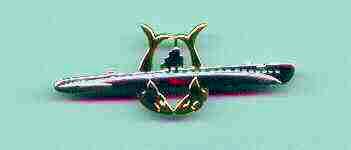


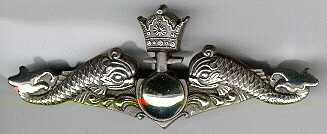
|
IRAN- In 1975, the United States and Iran came to an agreement for the U.S. to supply and train the Iranian Naval Submarine Force. By 1978, the first of the American-trained Iranians were ready to take over their new submarine, Kusseh. The Kusseh remained in Groton, Connecticut to train further members. Two more Guppy Class were transferred to Iran during this period. At the end of 1978 the agreement was cut off due to the overthrow of the Shah. Under the current Islamic government, the Iranian fleet consists of at least nine Italian and North Korean midget submarines. The Indian Navy is also providing technical support for the two Kilos also in the submarine force. During the period when Iran was training in the United States, the submarine badge was designed. The badge had two dorados supporting the Albacore submarine and is topped by the Pahlevi crown over the sail. The gold plated silver badge was for officers and the silver badge was for enlisted personnel. The badge is a clutchpin attachment. Miniatures are available. After the overthrow of the Shah, the Islamic Republic changed the badge to a design by the Soviets. The Islamic symbol was placed inside a gear wheel with anchor flukes below it. The gold badge is for officers and the silver badge is for enlisted personnel. The badge is a screw post attachment. |
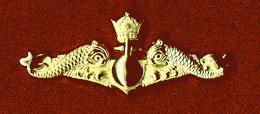


|
ISRAEL- In 1958, Israel obtained two obsolete British submarines. However, they were not operational until 1960 after refitting. At this time, Israel's current fleet contains three Gal Class, a German designed 206 coastal boat, and three Dolphin Class (German 209) submarines The Israel Submarine Badge issued in 1960 shows a submarine with the symbolic Israeli Military short sword entwined by a olive bracnch on its side tanks and conning tower. The badge is silver with a screw post attachment. The current Israel Submarine Badge was authorized in 1961. This badge shows a more stylized modern submarine. It is worn after completion of qualifications and after three years of service it is permanent. It is the same design as the original badge. The current badge differs depending on the manufacturer. This can be seen by the area around the anchor flukes and stock. One is pierced and the other is solid. The senior Submariner Badge uses the current badge but a it has a double wreath atopped by a star over the conning tower. This badge is given for ten years of service in the submarine service. The badges are clutchback or screw post attachment depending on manufacturer. The badge is made in silver metal but a gold version is made, but it is not authorized. |

|
ITALY- The first Italian submarine, Delfino, was commissioned in 1895 after being designed by Giacinto Pullino. It was originally battery powered, but was later refitted with a gasoline engine. This submarine was used through the first World War. Italy built several classes of submarines fro themselves and also as an export to other countries. Italy had a reputation in submarine technology and it was wanted by several other navies around the world, including the United States, England and Germany before World War I. German did not receive their's, but the U.S. and England were successful with theirs. At the start of World War I, Italy had 21 aged submarines. This lead to the upswing of production and obtaining designs from other countries. In 1916 and 1917, eight H Class boasts were delivered from Electric Boat and three were purchased from Great Britian. At the start of World War II, the Italian Submarine Fleet was 115 strong and thirty more joined the ranks during the war. Though these boats were not used for warfare, they were used primarily for transporting and delivery of supplies. At the end of the war, Italy was forced to give up her submarines for reparations. Only the Soviet Union took any. A few were savd for training and the rest were scrapped. In 1967, the Italians started building the Toti Class and Sauro Class submarine. The current fleet consists of 4 Sauro Class, 4 improved Sauro Class, and 1 Toti Class submarines. Italy is now one of the leading manufacturers of midget submarines and delivery vehicles. The Regia Marina Submarine Service Badge was authorized in 1924. Gold is for officers and silver is for enlistsed personnel. The badge is topped by the Savoy crown. These badges were only worn while serving in submarine service. The badge was a clutch pin or screw post attachment. In 1941, the Regina Marina authorized the Submarine Honor Badge, which is a larger version of the Submarine Service Badge. The badge was granted for life after five years of service (or 3 months for World War II combat duty) Gold is for officers and silver is for enlisted personnel. This badge remained in service unitl the fall of the Monarchy in 1946. In 1943, the Repubblica Sociale Italiana (RSI) created a new badge which was the same as the Regina Marina but the Savoy crown was removed. The qualifications were the same as the Honor Badge. It was worn on the right breast. The Badge for War Navigation is a shark above a torpedo on an anchor that has a line circumferencing the badge. The badge had three classes based on time in service. Bronze was for 18 months oon board or 1000 hours at sea. Silver was for 30 months on board or 3000 hours at sea. Gold was for 48 months on board or 5000 hours at sea. The time was basically a four for one deal. For example, one year at sea counted for four years. This badge is still authorized by World War II qualified personnel and is worn on the lower left breast. The current Service Badge (silver and blue enamel lettering) shown is for lower ranks and was authorized in 1990. The badge is worn on the left sleeve. The badge is clutch pin attachment. The current Service Badge for officers and petty officers is the same as the Honors Badges except the size is cut in half and the crown is different. The badge has the new Roman Naval crown atop of it. The badge is clutch pin or screw post attachment. The badge with the red enamel "A" is a Submarine Commemorative Badge. This one is for Atlantic Submarine Service. There is another one for Atlantic Servic in RSMC Argo. Both badges have the Savoy crown and were for service in Regis Marina. |


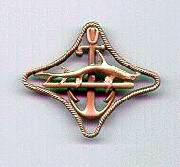
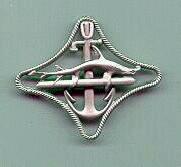
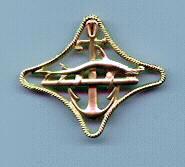

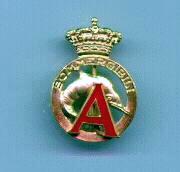
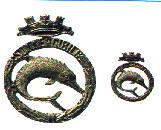
| Home Page |